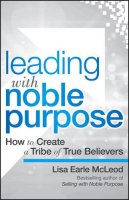
Leading with Noble Purpose by Lisa Earle McLeod

Read the summary below and get the key insights in just 10 minutes!


- Why employees disengage,
- How organizations can prioritize meaning over profits,
- What having a “Noble Purpose” accomplishes, and
- How to identify and activate your firm’s Noble Sales Purpose (NSP).

Monster.com and “Noble Purpose”
During a Super Bowl broadcast, Monster.com, the job site, ran memorable “When I Grow Up” commercials featuring children saying, “When I grow up I want to be a yes-man or yes-woman.” Another said, “When I grow up, I want to claw my way into middle management.”
Monster’s ads delivered the message: “You deserve a better job, and we want to help you find it.” That was Monster’s “Noble Purpose.” Founder Jeff Taylor connected the two ideas of a more desirable job and an improved life. This Noble Purpose paid dividends for Monster: In 2006, its website was one of the top 20 most visited on the Internet.
“Making money and making a difference are not incompatible. This duality is the birthright of every person on this planet.”
In 2007, a new team, led by CEO Sal Iannuzzi, took over Monster. Iannuzzi didn’t emphasize better employment opportunities for job searchers. He cared about corporate earnings. Without a leader dedicating the company to finding more fulfilling jobs for applicants, Monster’s purpose lost its nobility. Iannuzzi told employees his sole priority was “increasing shareholder value.” This new direction disappointed Monster employees. Some wrote online comments suggesting that Monster had “lost its soul.” Such employee comments emerge when companies revert from a “purpose-focus” to a “profit-focus.” Money and profits matter, but they seldom inspire employees. Customers rarely care about a company’s financial ambitions.
Iannuzzi cared about profits, not purpose. He had nothing to say about improving the lives of Monster’s customers. His decision to shift Monster away from its Noble Purpose proved to be a corporate disaster. By 2014, Monster’s stock price fell to an all-time low. During Iannuzzi’s tenure as CEO, its market capitalization suffered a 93% loss. Monster’s board fired him in 2014.
“Think about your own business. Is the driving question, ‘How can we make more money?’ Or, is the driving question, ‘How can we make a difference to our customers?’”
Monster’s Rebound
Thanks to a new CEO Timothy Yates, Monster is on the rebound. Yates’s “all the jobs, all the people” strategy turned its orientation from numbers back to customer welfare. It rededicated itself to helping job searchers find satisfying work. Monster rediscovered its Noble Purpose.
Many case studies demonstrate that when CEOs and senior leaders make purpose – not profit – their firms’ primary objective, the corporate “emotional undercurrent” shifts. Everything changes for the good within the organization and higher profits inevitably follow. Sales take on a higher meaning, a “Noble Sales Purpose” (NSP).
“As a leader, you’re the lynchpin. If your organization is going to rise above mediocrity, you have to be the one who takes it there.”
Hootsuite
Hootsuite, a Vancouver, Canada software-as-a-service (SaaS) firm, deliberately puts purpose above profits. Its NSP reads, “We empower our customers to turn messages into meaningful relationships.” Founded by Ryan Holmes in 2008, Hootsuite provides a platform for companies to manage multiple social networks efficiently. It has become the world’s most popular social relationship platform.
The company doesn’t pay exorbitant salaries or give employees plush offices and special benefits. Hootsuite’s “True Believers” love working for the firm because of its NSP. Hootsuite promotes its Noble Sales Purpose to employees by sponsoring “Story Offs” – events in which employees who deal directly with customers share their best “customer-impact” stories in 90 seconds or less. They describe the positive results customers achieve by using the Hootsuite platform. The storytellers focus on compelling details that inspire emotion and validate the NSP.
“To fully leverage the power of purpose, you have to name your purpose and then operationalize it.”
Story Offs inspire pride and motivate Hootsuite employees. The company considers the creation and communication of customer-impact stories so important that it makes storytelling a vital metric. Hootsuite’s methods bring extraordinary financial success. In the five years leading up to 2016, the company grew 56,000%.
Regardless of industry or product lines, companies that put purpose ahead of profits experience growth and stability. When a firm focuses on purpose, its employees concentrate on their customers. And customers reward them with consistent sales and profits. Employees of Noble Purpose firms stay motivated to do their best, enabling their firms to triumph over their rivals.
“Noble Purpose is the new narrative of business. It will enable you to deliver better results and become the kind of leader people want to follow.”
Purpose
In a discussion of purpose, Viktor Frankl, author of Man’s Search for Meaning, wrote, “Life is never made unbearable by circumstances, but only by lack of meaning and purpose.” People need their lives and effort – and their work – to matter.
Working at firms that lack purpose grinds employees down, making their jobs disheartening and unpleasant. Most white-collar employees regard their jobs as demoralizing and can’t attach any significance to their work. Fully 51% of employees don’t feel engaged with their jobs; another “17% actively disengage.” Their disconnection is a symptom of a lack of meaning in the workplace. This emptiness springs from companies putting profits foremost. At firms where money counts and purpose means nothing, the “money story” dominates, not the “meaning story.” Money is seldom an effective employee motivator. “You can’t spreadsheet your way to passion.” Corporate leaders who view their employees as commoditized line items will quickly learn that those workers regard their organizations only as a source of a paycheck, not as a source of pride.
“Purpose is like a plant. You have to water it, you have to tend to it [and] you have to nurture it. (G Adventures founder Bruce Poon Tip)
Companies that put purpose first are more profitable than companies that prioritize profits. Mike Gianoni, CEO of the cloud company Blackbaud, understands that “a healthy culture” includes honorable, trustworthy leaders who only hire those who care about the customers and employees who put clients’ needs first. A healthy culture turns a healthy profit.
Real-World Success
Examples of what can happen when firms operate with Noble Purpose include:
“With no common purpose guiding the organization, people tend to treat their individual or departmental goals as organizational goals.”
- A 10-year study of 50,000 brands indicates that companies which prioritize customers’ well-being and satisfaction grow at three times the rate of their competitors.
- Based on Deloitte’s 2015 workplace study, Deloitte chairman Punit Renjen said, “A strong sense of purpose drives businesses to take the long view and invest for growth.”
- Salespeople who want to make a contribution to their customers’ lives – those selling with a Noble Purpose – outperform salespeople focused on sales “targets and quotas.”
Effective Business Strategy
The best growth strategy is to operate with a Noble Purpose that brings “meaning back into the workplace.” These businesses serve customers best and motivate employees most effectively. Several factors differentiate companies that focus on profits from those that focus on purpose. Profit-focus firms ask how to increase earnings. They emphasize shareholder value. Their leaders care about “quarterly earnings, bonuses, stock price” and “efficiency measures.”
“Using the same benchmarks as everyone else in your industry doesn’t set the stage for competitive differentiation.”
Purpose-focus firms, which still work for a profit, ask how to “create more value for customers.” Their leaders urge employees to “make a difference in the lives of our customers.” Senior managers seek innovative differentiation. These leaders focus on “company values, customer impact, industry innovation” and “employee engagement.”
Implementing a Noble Strategy
Identifying your firm’s Noble Purpose requires analyzing what matters to your customers, how your organization differentiates itself from its rivals and how to “ignite” employees’ “emotional attachment.” To gather this information, assemble a cross-disciplinary team. Have its members answer and discuss three questions to develop your NSP:
“Relying on data alone enables leaders to avoid the messy emotional work of actually leading.”
- “How do you make a difference?” – Consider how your offering improves customers’ lives. Be as specific as possible.
- “How do you do it differently than your competition?” – Examine the “tangible and intangible” aspects of what makes your firm and the way it delivers its products or services stand out.
- “On your best day, what do you love about your job?” – This should elicit emotional – rather than rational – responses from your employees.
Once you establish your NSP, share it throughout your company. Start with a formal launch. Substantiate your NSP by sharing customer-impact stories. Make clear to employees that your NSP isn’t a “flavor-of-the-month tagline” or quickie corporate initiative.
“Bringing the customers to life in vivid ways sparks greater engagement, connection and innovation. Not humanizing the customers puts you at risk. It’s the death of emotional engagement. Customers wind up becoming a benign abstraction or even an intrusion.”
The Customer-Impact Story
An effective customer-impact story differs from a case study that covers only the facts. A customer-impact story – while true – appeals primarily to the emotions. It combines feelings with reason and facts. Launch your NSP by sharing your best stories throughout your company.
Prior to your launch, create “noble-purpose accelerators” to demonstrate that your company is already putting its NSP into action. For example, expand your service times, place your “client mission” at the beginning of all sales presentations and include customer-impact stories as the opening elements for meetings. Noble-purpose accelerators should directly align with your NSP and should direct the narrative in the direction of your customers.
“Every organization has an ethos: if not by design, then by default. The ethos is…collective beliefs about the organization’s identity.”
The NSP Launch
While introducing your NSP to your workforce in a full-fledged, public “official launch,” follow this sequence: Start the meeting or session with your best customer-impact story. Discuss the three questions that helped your team develop the NSP.
Ask audience members to meet in small groups to discuss their personal answers to the three questions. Then, ask the groups to share what they develop. After they do, say, “These are some of the same things the team and I recognized.” Then introduce the agreed-upon NSP to the audience. Tell everyone why you call it an NSP. Explain why the NSP matters to you personally. Outline the purposes of the launch: to make work meaningful for employees and to deliver maximum value to customers. Share your noble purpose accelerators.
After the launch, have department managers organize sessions during which employees discuss how the three questions apply to their particular units. Instead of having employees relate how the NSP applies to internal customers, emphasize external customers – the lifeblood of any business.
These discussions have three components: 1) Elucidate the NSP, 2) tell an NSP story and 3) have employees explain what the NSP means to them on personally. The NSP is what employees do, the story substantiates the NSP, and employees discuss how and why the NSP matters to them.
Develop plans to communicate the NSP and accompanying customer-impact stories throughout the organization. Line up enthusiastic supporters – your “Noble Knights.” Put them in charge of making the NSP an operational reality. Emphasize metrics and performance indicators that concern clients – “customer performance, client retention, customer comments, and so on.”
Hire “purposeful” people who want to work toward a Noble Purpose. Google, for example, wants employees to exhibit “Googliness.” Make alignment with your Noble Purpose an important evaluative measure. Promote your Noble Purpose at every turn, including in the annual report.
To sustain your Noble Purpose through successive CEO administrations, ask the board to make Noble Purpose part of the firm’s charter. These steps can transform employees into enthusiastic True Believers and extend your Noble Purpose throughout your company and among its clientele.[/text_block]
















